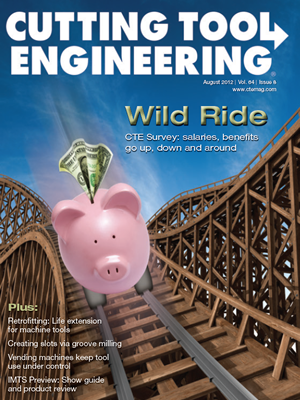Screws and screw threads hold millions of things together. Nearly as many types and forms of threads exist as there are products that use threaded fasteners and connections. Equally, there is much confusion and misuse of threads in general among those who aren’t “gearheads.”
From the machinist’s point of view, cutting threads is a satisfying experience. When you’re done, hopefully, you have two parts that mate together with a level of precision and smoothness not found in run-of-the-mill, hardware-grade fasteners. I have always enjoyed cutting threads on the manual lathe and have learned a few tricks over the years.

Courtesy of All images: T. Lipton
Align your threading tool against a freshly faced end or against the side of the chuck.
■ Align your threading tool against a freshly faced end or against the side of the chuck. The little arrow-shaped alignment tools you see are a pain and are only good for gaging hand-ground tool bits.
■ If you do a lot of threading on a manual lathe, invest in a tool that accepts inserts. The inserts are precisely ground and easily changed. One insert cuts dozens of thread pitches.
■ I learned how to thread on the lathe using the compound infeed method. Contrary to popular belief, the compound set doesn’t have to be at half the thread angle. By using what’s called “modified-flank infeed” and changing this angle, you help alleviate threading problems in difficult-to-cut materials.
■ Another advantage to threading with the compound is you don’t have to keep track of the dial position. The cross-feed dial is always zeroed after each pass, so you have less to remember, such as whether the last pass was at 0.030 " or 0.050 ". The main disadvantage is your Z-axis position changes as you feed in. This is usually not a problem on external threads, but it can be on internal threads that end against a shoulder.
■ Try the following strategies when you are ending threads and the part designer has not specified a thread. When I want to do something with the groove that gets cut at the end of the thread, I usually use the threading tool and traverse a small relief at the end. It saves a tool change and looks OK. If I want a nicer look, I switch to a radius tool. Just be sure the relief is a little smaller than the thread’s minor diameter so the mating part will thread all the way to the shoulder.

Keep a complete set of nuts on rings, with one ring for coarse threads and the other for fine threads.
■ Use a large DOC on your first pass during threading. The point is small; in the first couple of passes, the area of the tool tip engagement is also small. Taper your DOC as you get deeper. On the last pass, feed straight in with the cross-feed at a light 0.001 " spring cut. This cuts on both tool flanks and removes chatter and tool marks from the thread.
■ I can never remember which line on the threading dial to use with which thread pitch. If you’re lucky, it will be marked. When in doubt, just use the same number or line each time. Always use the same number when cutting multiple-start threads.
Do internal threading from the inside out with left-hand tools. You will get less chatter and see what’s happening down the bore. You will need left-hand threading tools, running the lathe in reverse. Remember, it’s easy to pull a rope; it’s really hard to push one.
■ When you have a choice, fine threads are easier to cut and need fewer passes than coarse ones. The shallower depth on difficult-to-cut materials might save your bacon.
■ For quick and easy day-to-day threading gages, I keep a complete set of nuts on rings in my toolbox for fitting threads. One ring holds coarse threads and the other holds fine ones. When you thread, be sure to run the nut the full length of the threads. When left to their own devices, machinists tend to cut threads tighter than necessary.
■ Mating materials in threaded connections are important. If you must use the same material for male and female threads, do yourself a favor and put a few molecules of thread lubricant or antiseize on them before you crank them together.

A thread file is ideal for straightening the annoying half thread fade at the beginning and end of an external thread.
■ If you do happen to get male and female threads wedged together in an intimate embrace, a simple trick to separate them is to quickly warm the female portion to 100° F or so, using a propane torch. A quick shot of penetrating lube before you twist might save the work.
■ When measuring threads, a dedicated thread micrometer is handy and quick to use at the machine. But for the highest accuracy, use the three-wire thread measuring method. This method is more accurate because the wires present a true parallel surface for measuring. If it’s good enough for the gage makers, it’s good enough for me.
■ A piece of modeling clay or window glazing putty can help hold pesky thread measuring wires. Better yet, buy a set of the plastic holders that fit the micrometer spindle.
■ Thread files actually work. They are great for straightening the annoying half thread fade at the beginning and end of an external thread. CTE
Related Glossary Terms
- chatter
chatter
Condition of vibration involving the machine, workpiece and cutting tool. Once this condition arises, it is often self-sustaining until the problem is corrected. Chatter can be identified when lines or grooves appear at regular intervals in the workpiece. These lines or grooves are caused by the teeth of the cutter as they vibrate in and out of the workpiece and their spacing depends on the frequency of vibration.
- chuck
chuck
Workholding device that affixes to a mill, lathe or drill-press spindle. It holds a tool or workpiece by one end, allowing it to be rotated. May also be fitted to the machine table to hold a workpiece. Two or more adjustable jaws actually hold the tool or part. May be actuated manually, pneumatically, hydraulically or electrically. See collet.
- feed
feed
Rate of change of position of the tool as a whole, relative to the workpiece while cutting.
- lathe
lathe
Turning machine capable of sawing, milling, grinding, gear-cutting, drilling, reaming, boring, threading, facing, chamfering, grooving, knurling, spinning, parting, necking, taper-cutting, and cam- and eccentric-cutting, as well as step- and straight-turning. Comes in a variety of forms, ranging from manual to semiautomatic to fully automatic, with major types being engine lathes, turning and contouring lathes, turret lathes and numerical-control lathes. The engine lathe consists of a headstock and spindle, tailstock, bed, carriage (complete with apron) and cross slides. Features include gear- (speed) and feed-selector levers, toolpost, compound rest, lead screw and reversing lead screw, threading dial and rapid-traverse lever. Special lathe types include through-the-spindle, camshaft and crankshaft, brake drum and rotor, spinning and gun-barrel machines. Toolroom and bench lathes are used for precision work; the former for tool-and-die work and similar tasks, the latter for small workpieces (instruments, watches), normally without a power feed. Models are typically designated according to their “swing,” or the largest-diameter workpiece that can be rotated; bed length, or the distance between centers; and horsepower generated. See turning machine.
- micrometer
micrometer
A precision instrument with a spindle moved by a finely threaded screw that is used for measuring thickness and short lengths.
- parallel
parallel
Strip or block of precision-ground stock used to elevate a workpiece, while keeping it parallel to the worktable, to prevent cutter/table contact.
- pitch
pitch
1. On a saw blade, the number of teeth per inch. 2. In threading, the number of threads per inch.
- relief
relief
Space provided behind the cutting edges to prevent rubbing. Sometimes called primary relief. Secondary relief provides additional space behind primary relief. Relief on end teeth is axial relief; relief on side teeth is peripheral relief.
- threading
threading
Process of both external (e.g., thread milling) and internal (e.g., tapping, thread milling) cutting, turning and rolling of threads into particular material. Standardized specifications are available to determine the desired results of the threading process. Numerous thread-series designations are written for specific applications. Threading often is performed on a lathe. Specifications such as thread height are critical in determining the strength of the threads. The material used is taken into consideration in determining the expected results of any particular application for that threaded piece. In external threading, a calculated depth is required as well as a particular angle to the cut. To perform internal threading, the exact diameter to bore the hole is critical before threading. The threads are distinguished from one another by the amount of tolerance and/or allowance that is specified. See turning.


